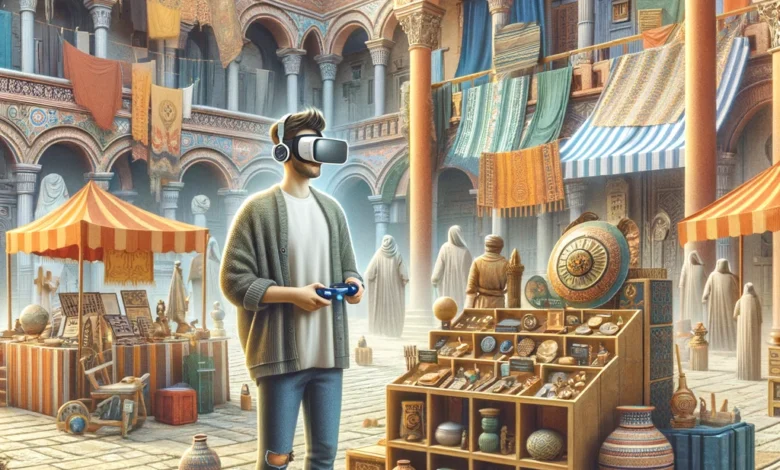Unlocking the Classroom of Tomorrow: The Revolutionary Impact of VR on Education

Ah, the realm of virtual reality (VR) and its burgeoning impact on education—a topic that feels like someone took the future and smacked it right onto our present-day classroom desks, complete with a side of digital awe. Let’s dive into this cybernetic odyssey with a touch of humor and a dash of insight.
Introduction: The Virtual Classroom Revolution
Picture this: a world where students don goggles and are instantly transported to ancient Rome, the human bloodstream, or even the surface of Mars. This isn’t the plot of the latest sci-fi blockbuster but the current reality of education augmented by virtual reality. VR in education is like the cool teacher everyone remembers—the one who made learning not just informative but downright exhilarating.
Background: From Chalkboards to Virtual Worlds
Historically, education has evolved from rote learning in one-room schoolhouses to interactive, digital classrooms. However, the leap to VR represents a quantum jump akin to swapping a horse and buggy for a teleportation device. It’s a transformation that’s reshaping how knowledge is conveyed, making the leap from passive absorption to immersive experience.
VR’s Role in Shaping Modern Education
The advent of VR technology in the educational sector has opened up realms previously confined to the imagination, offering a hands-on, immersive experience that traditional methods of teaching could scarcely compete with. Here’s a more detailed exploration:
- Enhanced Engagement and Interactivity: VR has the unique ability to captivate students’ attention in ways that textbooks and lectures simply cannot. By placing learners inside a virtual environment, subjects become tangible and interactive. Students can conduct physics experiments in zero gravity, dive into the depths of the ocean to study marine biology, or stand in the middle of historical events, gaining a 360-degree view of history as it unfolds around them. This level of engagement not only makes learning more enjoyable but also significantly improves retention rates.
- Breaking Down Complex Concepts: Abstract and complex subjects often pose significant challenges in traditional learning environments. VR simplifies these concepts by providing a visual and experiential learning context. For instance, students can visualize mathematical equations in three dimensions or step inside a living cell to see molecular biology in action. This hands-on approach demystifies complex ideas, making them more accessible to students of all learning styles.
- Encouraging Exploration and Discovery: One of VR’s most compelling aspects is its ability to foster a sense of curiosity and exploration. Students are not just passive recipients of information but active participants in their learning journeys. They can explore ancient ruins, conduct experiments in simulated labs, or navigate through the human body, all at their own pace. This freedom encourages a deeper, more personal connection to the material, igniting a passion for discovery and lifelong learning.
- Safe Simulation of Dangerous or Impossible Scenarios: VR provides a safe environment for students to practice and learn from scenarios that would be too dangerous, expensive, or impractical to experience in real life. Medical students can perform virtual surgeries, chemistry students can conduct explosive experiments, and engineering students can test the structural integrity of large constructions without any risk, preparing them for real-world applications of their studies with confidence.
- Global Classroom Experiences: VR transcends geographical limitations, offering students a global classroom. Through virtual exchange programs, students can visit international landmarks, understand different cultures, or collaborate with peers from around the world without leaving their classroom. This global perspective is invaluable in cultivating a more inclusive, empathetic worldview.
- Personalized Learning Environments: VR can adapt to the individual needs and learning speeds of each student, offering personalized educational experiences. Through intelligent VR applications, content can adjust in real-time to suit the learner’s proficiency level and learning style, providing additional support or challenges as needed. This personalized approach ensures that all students can achieve their full potential, regardless of their starting point.
Case Studies/Examples
Stanford University’s Virtual Heart Project:
-
- Background: Stanford’s VR heart project is a pioneering effort to enhance medical education through immersive learning. By using VR, medical students can explore the human heart in three dimensions, gaining insights into its structure and function that would be impossible with traditional 2D images or textbooks.
- Impact: The project has significantly improved students’ understanding of complex cardiovascular concepts and conditions. It offers an unparalleled view of heart anatomy, enabling students to visualize and interact with different heart diseases and treatments in a controlled, virtual environment. This hands-on experience has proven invaluable in preparing future healthcare professionals for the challenges of diagnosing and treating heart-related conditions.
The Anne Frank House VR:
-
-
- Background: This virtual reality tour recreates the secret annex where Anne Frank and her family hid during World War II. It serves as an educational tool that provides a deeply immersive and emotional experience, bringing history to life in a way that traditional textbooks cannot.
- Impact: By walking through the faithfully reconstructed rooms, students gain a unique perspective on Anne Frank’s life and the events of the Holocaust. This VR experience fosters empathy and a deeper understanding of historical events, encouraging students to reflect on the importance of tolerance and the impact of history on today’s society.
-
Google Expeditions:
-
- Background: Google Expeditions is a VR education platform that allows students and teachers to take virtual field trips to hundreds of destinations around the world, including museums, underwater landscapes, and even outer space.
- Impact: The platform has democratized access to global landmarks and natural wonders, offering students from all socioeconomic backgrounds the opportunity to explore and learn about places they might never have the chance to visit in person. Google Expeditions enhances classroom lessons with vivid, immersive experiences, making learning more engaging and memorable.
Labster’s Virtual Labs:
-
- Background: Labster offers virtual laboratory simulations designed to improve science education by allowing students to conduct scientific experiments in an online VR environment. Covering a wide range of scientific disciplines, these simulations provide students with the opportunity to practice and apply scientific concepts in a safe, cost-effective manner.
- Impact: Labster’s VR labs have been shown to increase student motivation and learning outcomes by providing hands-on experience with complex experiments, from genetic engineering to environmental science. This approach not only enhances students’ understanding of scientific principles but also prepares them for real-life laboratory work, bridging the gap between theory and practice.
Zspace
-
- Background: Zspace is a technology firm that integrates VR and AR (augmented reality) into a unique learning platform, utilizing specialized hardware and software to create interactive, multidimensional experiences for education.
- Impact: Used across K-12 and higher education, Zspace’s immersive learning experiences cover a wide range of subjects, including STEM, social sciences, and the arts. By making learning visually engaging and interactive, Zspace helps students grasp complex concepts more easily and retain information longer, proving that immersive technology can fundamentally change the way knowledge is acquired.
Future Outlook: Where Do We Go from Here?

The trajectory of VR in education is on an exhilarating upswing, promising a future where learning is not just about memorization but about experience, exploration, and engagement. The forward march of VR technology suggests a few key trends and possibilities:
- Wider Accessibility and Affordability: As VR technology advances, the cost of VR headsets and equipment is expected to decrease, making it more accessible to schools and individuals around the globe. This democratization of technology will enable a broader spectrum of learners to experience immersive education, breaking down financial and geographical barriers to quality education.
- Integration with AI and Machine Learning: The fusion of VR with artificial intelligence (AI) and machine learning promises personalized learning experiences that adapt in real-time to the needs of the student. Imagine a VR classroom that can assess a student’s understanding of a topic as they interact with the content and adjust the difficulty level or suggest new topics accordingly. This adaptive learning environment could revolutionize education by catering to the unique learning pace and style of each student.
- Expansion of Content and Disciplines: While VR in education has seen significant application in fields like history, science, and medicine, the future will likely bring an expansion of VR content across a wider range of disciplines, including arts, languages, and social sciences. This broadening of scope will provide learners with a more comprehensive, immersive educational experience.
- Global Collaboration and Virtual Exchange Programs: VR technology enables real-time collaboration across distances, opening up possibilities for international virtual exchange programs where students from different parts of the world can learn and work together on projects in a virtual environment. This global classroom concept will foster cross-cultural understanding and cooperation, preparing students for a more interconnected world.
- Ethical and Empathetic Learning Experiences: VR’s ability to simulate real-life scenarios and historical events offers a unique opportunity for teaching empathy and ethics. By virtually placing students in someone else’s shoes, VR can promote a deeper understanding of social issues, diversity, and the consequences of actions, nurturing more empathetic and socially responsible individuals.
Challenges/Controversies: The VR Education Debate
Despite the promising future, the road to integrating VR into education is not without its bumps and curves. Several challenges and controversies accompany the adoption of VR in educational settings:
- Digital Divide and Equity Concerns: The initial cost and technological requirements of VR pose a significant barrier, risking a widening of the digital divide. Ensuring equitable access to VR technology for students from all socio-economic backgrounds remains a paramount challenge.
- Health and Safety Issues: Prolonged use of VR can raise health concerns, including eye strain, motion sickness, and cognitive overload. Establishing guidelines for safe use, particularly for younger students, is crucial to mitigating these risks.
- Content Quality and Educational Value: As the market for educational VR content grows, so does the variability in quality. Ensuring that VR experiences are not only engaging but also pedagogically sound and aligned with curriculum standards is essential for their effective integration into education.
- Technological Infrastructure and Teacher Training: The successful implementation of VR in education requires significant investment in technological infrastructure and professional development for educators. Teachers need to be equipped with the skills to effectively integrate VR into their teaching practices and to navigate the technical challenges that may arise.
- Privacy and Data Security: With the increased use of VR and associated technologies, concerns around data privacy and security come to the forefront. Protecting students’ personal information in virtual spaces is critical, necessitating robust security measures and clear guidelines on data usage.
Looking Ahead
As we navigate these challenges, the conversation around VR in education continues to evolve. Balancing the potential benefits with the ethical considerations and logistical hurdles will be key to harnessing the full power of VR in shaping the future of education. The journey ahead is as much about innovation in technology as it is about fostering an inclusive, equitable, and safe learning environment for all students.
Conclusion
The integration of VR into education represents a significant leap forward, not just in how we teach, but in how we conceive of learning itself. By transforming abstract concepts into interactive experiences, VR has the potential to make education more engaging, accessible, and effective for students worldwide. As we continue to explore the capabilities of this technology, the future of education looks not just bright, but utterly immersive.




